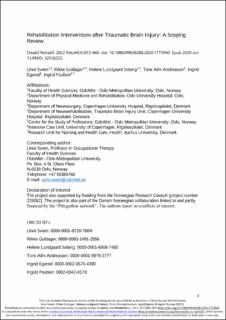| dc.contributor.author | Sveen, Unni | |
| dc.contributor.author | Guldager, Rikke | |
| dc.contributor.author | Søberg, Helene Lundgaard | |
| dc.contributor.author | Andreassen, Tone Alm | |
| dc.contributor.author | Egerod, Ingrid | |
| dc.contributor.author | Poulsen, Ingrid | |
| dc.date.accessioned | 2021-01-31T10:43:24Z | |
| dc.date.accessioned | 2021-03-08T17:30:41Z | |
| dc.date.available | 2021-01-31T10:43:24Z | |
| dc.date.available | 2021-03-08T17:30:41Z | |
| dc.date.issued | 2020-06-13 | |
| dc.identifier.citation | Sveen, Guldager, Søberg, Andreassen, Egerod, Poulsen. Rehabilitation interventions after traumatic brain injury: a scoping review. Disability and Rehabilitation. 2020:1-9 | en |
| dc.identifier.issn | 0963-8288 | |
| dc.identifier.issn | 1464-5165 | |
| dc.identifier.uri | https://hdl.handle.net/10642/9928 | |
| dc.description.abstract | Purpose: To (1) identify interventional research topics in traumatic brain injury (TBI) rehabilitation, (2) describe potential knowledge gaps, and (3) uncover further needs for interventional TBI rehabilitation research for patients and families.
Method: We searched three databases (2006–2019) and screened 1552 non-duplicate articles. Titles and abstracts were screened for relevance, yielding 754 articles for full-text review. Of these, 425 were included, as relevant to the purpose of the scoping review.
Findings: Among articles on TBI rehabilitation, the majority (71.8%) applied quantitative methodology; of these only 19.7% were randomized controlled trials. Severe TBI was described more often than mild/moderate TBI populations. Hospital vs community/home rehabilitation was 55.1% vs 37.2%; rehabilitation at workplace/school was described in only 4.5% articles, while in 7.2% the setting was undisclosed. Of 83 articles describing work/education, only 14 were in a work/school context. An additional focus in the work/education articles was activities of daily living (n = 28), cognition (n = 33) and emotions (n = 23), few targeted family or network.
Conclusion: The main attention of interventional TBI rehabilitation studies has been on severe TBI and long-term rehabilitation. Gaps identified were rehabilitation of mild/moderate TBI populations, older populations, acute/sub-phase rehabilitation, return to work issues and studies including the family. | en |
| dc.description.sponsorship | The project was supported by funding from the Norwegian Research Council (project number 229082). The project is also part of the Danish-Norwegian collaboration linked to and partly financed by the “Phlegethon network.” | en |
| dc.language.iso | en | en |
| dc.publisher | Routledge | en |
| dc.relation.ispartofseries | Disability and Rehabilitation; Volume 44, 2022 - Issue 4 | |
| dc.rights | Creative Commons Attribution-NonCommercial-NoDerivatives 4.0 International (CC BY-NC-ND 4.0) | en |
| dc.rights.uri | https://creativecommons.org/licenses/by-nc-nd/4.0/ | |
| dc.subject | Traumatic brain injuries | en |
| dc.subject | Rehabilitation | en |
| dc.subject | Interventions | en |
| dc.subject | Scopes | en |
| dc.subject | Rehabilitation settings | en |
| dc.title | Rehabilitation interventions after traumatic brain injury: a scoping review | en |
| dc.type | Journal article | en |
| dc.type | Peer reviewed | en |
| dc.date.updated | 2021-01-31T10:43:24Z | |
| dc.description.version | acceptedVersion | en |
| dc.identifier.doi | https://doi.org/10.1080/09638288.2020.1773940 | |
| dc.identifier.cristin | 1819309 | |
| dc.source.journal | Disability and Rehabilitation | |
| dc.relation.projectID | Norges forskningsråd: 229082 | |

